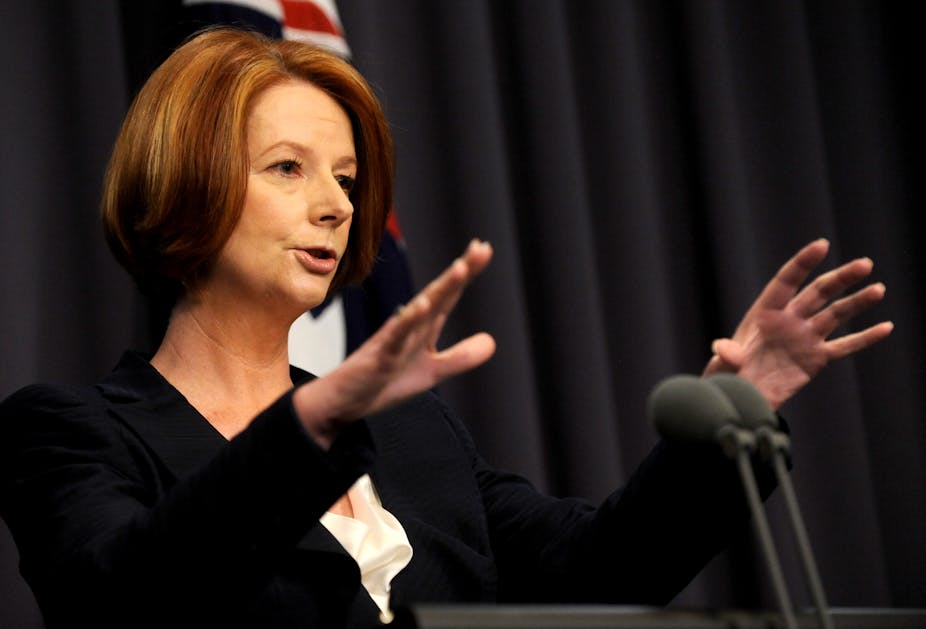It might seem that the days before Christmas would be an odd time to announce a cabinet reshuffle, but for the Prime Minister it was the latest in a series of manoeuvres designed to help the government reconnect with the electorate.
As the federal parliamentary year drew to a close, Gillard and her Labor colleagues had some cause for feeling a bit more confident about the future.
Gillard had had a good three weeks, having had good press coverage of her role at Commonwealth Heads of Government Meeting (CHOGM) and in hosting the visit of US president Barack Obama, and succeeding in getting the mining tax through the House of Representatives.
A last minute manoeuvre over the position of Speaker that exposed Liberal leader Tony Abbott to questions about his capacity as opposition leader seemed to be icing on the cake.
As the last of the opinion polls for the year came in, Labor’s mood may well have darkened. While there was positive news in the form of an increase in Gillard’s personal rating as preferred prime minister according to Newspoll, Labor’s primary vote and the critical two-party vote fell. Fairfax media’s polls confirmed the downward trend a week later .
The polls may be revealing the uncomfortable fact for the government that the Australian electorate is not listening to it. The collapse in voter support for the government that occurred as it mired itself in the carbon tax and asylum seeker debates in the months immediately after the election has not recovered.
This is despite the fact that some aspects of the political environment have improved for Labor. Prime minister Gillard and her colleagues have managed to consolidate their relationship with the cross-bench MPs who hold the balance of power in the Representatives, and the change-over in the Senate on July 1 this year meant that Gillard’s legislative program was no longer the mercy of erratic Senate cross-benchers Nick Xenophon and Steve Fielding.
Gillard has struggled with the impression that her administration is overly influenced by the Greens, but the ability of the government to get its legislation through the parliament ought to be something of an advantage, especially in its bid to try to cast the Liberal-National coalition as bereft of policy ideas.
But for all the improving conditions and the dominance Gillard enjoyed over the news agenda during the Obama visit and the CHOGM meeting, voter support for the government remains at a critically low level.
The problem for Gillard is that she has struggled to find a way to re-engage with the electorate over matters the government wants to talk about (as distinct from the sort of engagement that can occur over things the government would rather avoid such as a leadership challenge that might involve the foreign minister, Kevin Rudd).
With the national parliament shut for the year, denying the government the opportunity to try to get the electorate’s attention by way of legislation, the prime minister has gone for the next available tactic to impact on the debate: a ministerial reshuffle.
The task of putting ministries together is always highly political, so the winners and losers in this reshuffle reflect political considerations rather than perceived competence of those being moved and those staying put.
Thus Joe Ludwig, loathed by Australia’s rural industry lobby, stays in the cabinet and remains agriculture minister presumably because Gillard needs the support of Ludwig’s allies who, it so happens, are co-ordinated by the minister’s father.
Mark Butler comes in to the cabinet because he is a left faction convenor. Bill Shorten comes in because he is the right faction’s preferred candidate for leader, but, given the state of the opinion polls just now, his leadership ambitions are on hold. Kim Carr goes out of the cabinet because he is being seen as being too close to Kevin Rudd’s leadership ambitions.
Indeed, the reshuffle Gillard presided over is not that extensive. Carr has gone, but three new ministers come in and so the cabinet has increased by two. There has been a minor rejigging of the portfolio responsibilities to cover the departure of Carr and the arrival of Shorten, Butler and former housing minister Tanya Plibersek whose elevation has been trumpeted by the prime minister of further confirmation of her feminist credentials. Clearly Labor has decided to try to appeal to women voters again.
The bottom line in national politics as it stands is that Labor is in diabolical trouble. Labor would only have to lose one or two seats at the next federal election to lose government. The polls currently indicate that Labor’s losses could be as high as 33 seats.
The polls’ refusal to change is indicative of a sullen electorate that has given up on the government and is waiting (as former Queensland premier Wayne Goss once put it back in 1996 when former primer minister Paul Keating’s unpopularity was at commensurate levels) with baseball bats.
Gillard needs to do something to break down the electorate’s disdain for her government. Having a ministerial reshuffle is something that can be done, and so she has done it.

